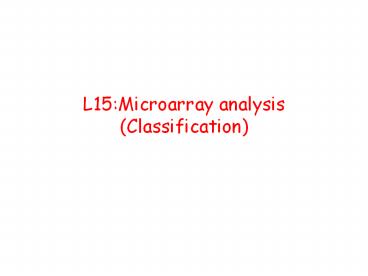L15:Microarray analysis (Classification) - PowerPoint PPT Presentation
Title:
L15:Microarray analysis (Classification)
Description:
L15:Microarray analysis (Classification) – PowerPoint PPT presentation
Number of Views:91
Avg rating:3.0/5.0
Title: L15:Microarray analysis (Classification)
1
L15Microarray analysis (Classification)
2
The Biological Problem
- Two conditions that need to be differentiated,
(Have different treatments). - EX ALL (Acute Lymphocytic Leukemia) AML (Acute
Myelogenous Leukima) - Possibly, the set of genes over-expressed are
different in the two conditions
3
Geometric formulation
- Each sample is a vector with dimension equal to
the number of genes. - We have two classes of vectors (AML, ALL), and
would like to separate them, if possible, with a
hyperplane.
4
Hyperplane properties
- Given an arbitrary point x, what is the distance
from x to the plane L? - D(x,L) (?Tx - ?0)
- When are points x1 and x2 on different sides of
the hyperplane? - Ans If D(x1,L) D(x2,L) lt 0
x
?0
5
Separating by a hyperplane
- Input A training set of ve -ve examples
- Recall that a hyperplane is represented by
- x-?0?1x1?2x20 or
- (in higher dimensions) x ?Tx-?00
- Goal Find a hyperplane that separates the two
classes. - Classification A new point x is ve if it lies
on the ve side of the hyperplane (D(x,L)gt 0) ,
-ve otherwise.
6
Hyperplane separation
- What happens if we have many choices of a
hyperplane? - We try to maximize the distance of the points
from the hyperplane. - What happens if the classes are not separable by
a hyperplane? - We define a function based on the amount of
mis-classification, and try to minimize it
7
Error in classification
- Sample Function sum of distances of all
misclassified points - Let yi-1 for ve example i, yi1 otherwise.
- The best hyperplane is one that minimizes D(?,?0)
- Other definitions are also possible.
?
x2
-
x1
8
Restating Classification
- The (supervised) classification problem can now
be reformulated as an optimization problem. - Goal Find the hyperplane (?,?0), that optimizes
the objective D(?,?0). - No efficient algorithm is known for this problem,
but a simple generic optimization can be applied. - Start with a randomly chosen (?,?0)
- Move to a neighboring (?,?0) if D(?,?0)lt
D(?,?0)
9
Gradient Descent
- The function D(?) defines the error.
- We follow an iterative refinement. In each step,
refine ? so the error is reduced. - Gradient descent is an approach to such iterative
refinement.
D(?)
D(?)
?
10
Rosenblatts perceptron learning algorithm
11
Classification based on perceptron learning
- Use Rosenblatts algorithm to compute the
hyperplane L(?,?0). - Assign x to class 1 if f(x) gt 0, and to class 2
otherwise.
12
Perceptron learning
- If many solutions are possible, it does no choose
between solutions - If data is not linearly separable, it does not
terminate, and it is hard to detect. - Time of convergence is not well understood
13
Linear Discriminant analysis
- Provides an alternative approach to
classification with a linear function. - Project all points, including the means, onto
vector ?. - We want to choose ? such that
- Difference of projected means is large.
- Variance within group is small
14
LDA contd
- What is the projection of a point x onto ??
- Ans ?Tx
- What is the distance between projected means?
x
15
LDA Contd
Fisher Criterion
16
LDA
Therefore, a simple computation (Matrix inverse)
is sufficient to compute the best separating
hyperplane
17
Maximum Likelihood discrimination
- Suppose we knew the distribution of points in
each class. - We can compute Pr(x?i) for all classes i, and
take the maximum
18
ML discrimination recipe
- We know the distribution for each class, but not
the parameters - Estimate the mean and variance for each class.
- For a new point x, compute the discrimination
function gi(x) for each class i. - Choose argmaxi gi(x) as the class for x
19
ML discrimination
- Suppose all the points were in 1 dimension, and
all classes were normally distributed.
?1
?2
x
20
ML discrimination (multi-dimensional case)
Not part of the syllabus.
21
Dimensionality reduction
- Many genes have highly correlated expression
profiles. - By discarding some of the genes, we can greatly
reduce the dimensionality of the problem. - There are other, more principled ways to do such
dimensionality reduction.
22
Principle Components Analysis
- Consider the expression values of 2 genes over 6
samples. - Clearly, the expression of the two genes is
highly correlated. - Projecting all the genes on a single line could
explain most of the data. - This is a generalization of discarding the gene.
23
PCA
- Suppose all of the data were to be reduced by
projecting to a single line ? from the mean. - How do we select the line ??
m
24
PCA contd
- Let each point xk map to xk. We want to mimimize
the error - Observation 1 Each point xk maps to xk m
?T(xk-m)?
xk
?
xk
m































